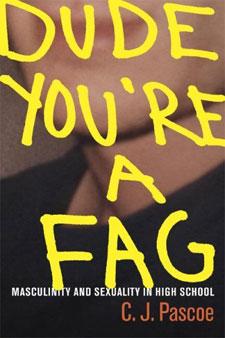For many queers high school is a difficult time where just getting by can be a daily struggle. Many teens adopt strategies to cope, like repressing their sexuality in an attempt to avoid homophobic bullying. Some just try to stick it out. Some do not survive.
While many see high school as a stressful time, most adults chalk it up to a painful but obligatory rite of passage and give it no more thought. Indeed among adults discussions around schooling are often made out to be the exclusive province of (presumed to be heterosexual) parents. As a result the social organization of high schools is excluded from public debate, especially when it comes to sexuality and gender.
In her highly readable book Dude, You’re a Fag: Masculinity and Sexuality in High School, US sociologist CJ Pascoe explores the ways in which high-school culture regulates gender and sexuality in everyday life and administrative practices. Her findings won’t surprise those of us who’ve experienced the degradation rituals heaped on queers in the crucible of high-school cultures.
Pascoe spent 18 months doing fieldwork at a working-class high school in California. Based on direct observation, in-depth interviews with 50 students and rich descriptions of school events, dances and everyday behaviour, Pascoe’s research uncovers how schools produce damaging norms around gender and sexuality reflected and perpetuated through student culture and through teachers and school administration.
For example, Pascoe relates how an annual popular student performance, dubbed the Mr Cougar competition, emphasizes power over girls’ bodies (featuring swooning girls) as the most valued and obligatory way to be masculine. These school plays feature hackneyed themes involving boys rescuing girls from unknown dangers and the promotion of brute bodily strength in the various skits. These styles of masculinity are underwritten by a rejection of other boy-actors who do not conform to this ideal.
Her research also reveals how the official curriculum and school administrators fail to intervene when instances of sexist and homophobic harassment emerge in student cultures and are represented in official school events. The failure to rectify unequal relations among boys and girls and straight and queer students reinforces and normalizes a culture of sexual harassment and homophobia in schools that becomes coded as normal male adolescent development.
There is virtually no administrative support to actively intervene in social and institutional patterns that create an unsafe environment for many queer and trans students. This point is hit home when Pascoe describes the barriers that students faced to start a Gay/Straight Alliance (GSA) at the school. Her interviews with members of the GSA reveal overt interference by teachers and administration and an active culture of discouragement in their endeavours, even while other student initiatives were actively supported.
Although there’s been ample research that looks at homophobic attitudes and behaviours in schools, Pascoe’s research is novel in that it collects empirical evidence for the interrelated effects of sexism and homophobia in the social world of schools. Pascoe describes school culture as an especially intensive site for compulsive heterosexuality, revealed through students’ behaviour and attitudes as well as an entrenched part of the unofficial curriculum in schools. She describes the quality of discussions and behaviour of the boys in shop class and in the weight room, showing how everyday talk of “getting girls” and masculine bluster reveals a sense of entitlement to girls’ bodies and sex. At times their discussions veer into a barely concealed talk of sexual harassment and date rape, constructed as a normal part of heterosexual male interactions with girls.
Pascoe’s research also uncovers a dizzying and absurd array of behaviours and attitudes that attract the epithet “fag” in contemporary teen culture. Use of the perennial homophobic term of abuse has stretched to become a potent tool that both regulates male gender behaviour and marginalizes queer adolescents. Like the use of “gay” as a pejorative, hetero boys use the term to distance themselves from anything deemed unmasculine or uncool. The elasticity of the term — which Pascoe notes may be used against an unfortunate student for nothing more dramatic than a piece of meat falling out of his sandwich — means it acquires an almost mythic status to regulate social space and behaviour mainly among males. It seems as though in a time when queer and trans adolescent visibility is increasing the social norms that regulate straight adolescent male behaviour are becoming more restricted, far-reaching and perhaps even more paranoid.
Pascoe’s work shows that what is being made into “normal” adolescent male behaviour is profoundly political, acquiring its normal status through the exclusion of others. Girls adopt conciliatory attitudes and avoid confronting the dominance rituals that some boys display. Queer survival practices such as avoidance behaviour, lack of participation and adopting different clothing styles as a form of resistance are ones that many queers can relate to during their time at high school.
Contrary to liberal democratic thinking that takes formal equality as its mantra Pascoe’s work uncovers entrenched inequalities that continue to position queers and others outside mainstream gender behaviour as vulnerable to exclusion, harassment and violence. Regardless of equality documents on file with the school board Pascoe finds little social space for students who are unable or unwilling to conform to dominant norms.
At a time when bullying in schools is receiving greater attention Pascoe’s work is a much-needed corrective to the pat psychological tone of much of these discussions. Bullying is often coded as an individual problem, rarely linked to a wider culture of sexist and homophobic practices sustained by the social organization of schooling. Instead of focusing on an individually disturbed teen her work reveals how the culture of producing “normal” boys and girls in high schools is accomplished on an everyday basis and supported by teachers and administrators who do little to intervene in practices of blatant sexism and homophobia that permeate the lives of youth.

 Why you can trust Xtra
Why you can trust Xtra


